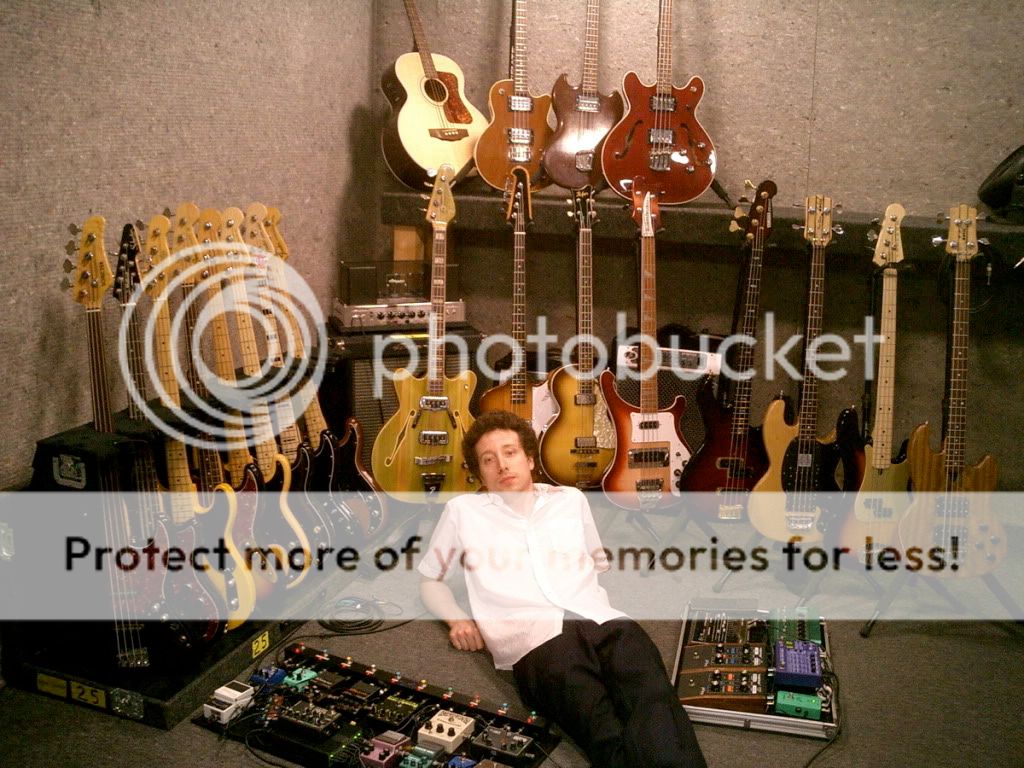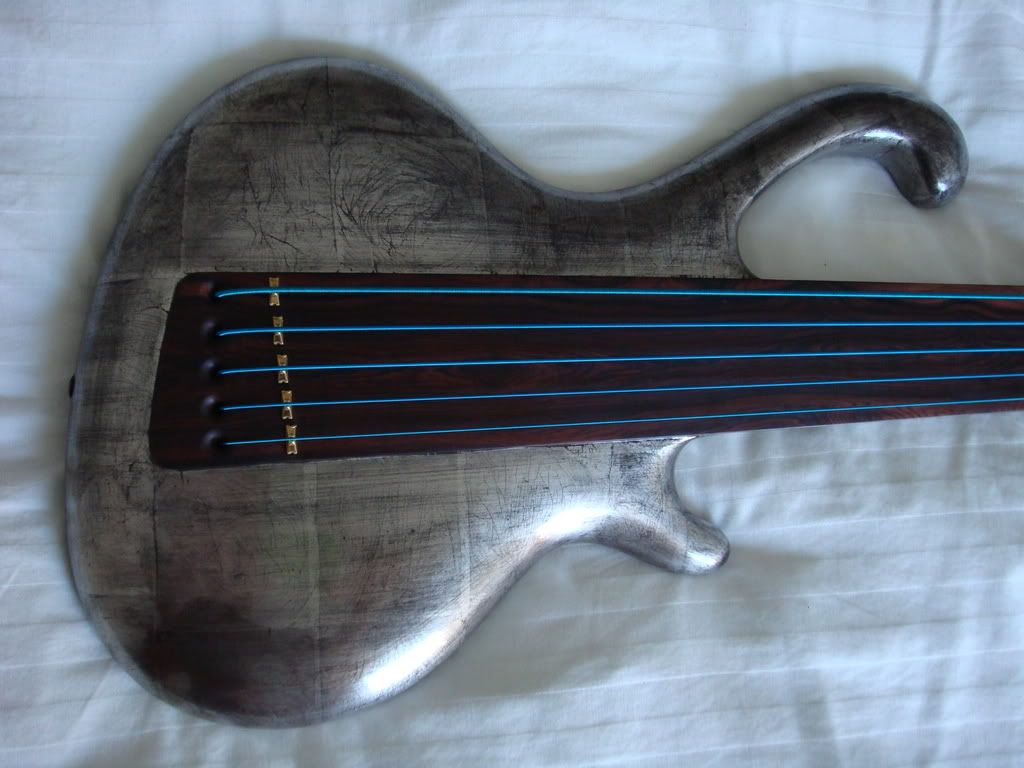 I generally don’t do reviews of products–mainly because nobody sends me anything to review. If I’m interested in something, I have to go out and buy it and pay full retail.
I generally don’t do reviews of products–mainly because nobody sends me anything to review. If I’m interested in something, I have to go out and buy it and pay full retail.And that’s exactly what I did with the Kala Hutch Hutchinson Signature Limited Edition uBass. I went out and bought one so I could not only review it here, but play it and enjoy it as I have my Mahogany uBass.
I first noticed the Double H (as I like to call it) in a video of Bakithi Kumalo at the Kala booth at the Winter NAMM 2011 show. It was hanging on the wall behind him. What caught my eye was the distinctive “slash” soundhole. I instantly fell in love with its looks. So I emailed Mike Upton at Kala and asked what it was, if it was available and how much it cost. I received a reply from Joy stating that it was a limited production signature model and that they had just sold their last two models to a retailer (who just happened to be near me). So I emailed the retailer and told them that Kala was sending them two Double Hs and to reserve one for me. The retailer confirmed that they were indeed on their way and put one aside for me.
Nearly two weeks of anticipation later, it finally shows up at my doorstep. I drag the box in, rip it open, unzip the gig bag–and there it is. The Double H in all its glory. I knew I would not be disappointed. And I wasn’t.
After letting the Double H warm up for a few hours (it traveled from Sunny California, to the cold and very snowy East Coast) I tuned it up and started plucking away. It sounded and felt great.
Since I already owned a Mahogany uBass for about six months or so, I sort of knew what
to expect from the Double H. The biggest surprise for me was that there were few differences between the Double H and the Mahogany. Since it is a signature model I was expecting something radically different. But I guess you really can’t improve on perfection, only tweak it a bit here and there. They both are made of Mahogany (with the Double H having a Spruce top glued on). They are exactly the same dimensions and 21″ scale. The strings, bridge, saddles and end pin/input sockets are the same. They both use the same pickup under the bridge.
But that’s not to say the Double H and the Mahogany are exactly alike. They are not.
The Mahogany uses Hipshot licensed tuners (which are marked, not surprisingly, “Hipshot Licensed”). The tuners on the Double H are not marked. They look like Hipshot tuners, but I can’t tell for sure if they are. I suspect they are.
The neck, back and sides on both uBasses are Mahogany. The Mahogany has a Rosewood fingerboard. The Double H has what looks to be a thin piece of Ebony. They both have the same “roadkill” Road Toad Music frog inlay on the headstock and the Kala logo.
The biggest difference between the two models–besides the Spruce top on the Double H–is the cutaway that gives you easy access to the 13th, 14th, 15th and 16th frets. The fingerboard on the Double H is angled at the bottom. On the Mahogany it has a straight bottom edge.
The first thing you notice about the Double H–and what first got me interested in it–is the distinctive “slotted” soundhole. Where the Mahogany has a traditional round soundhole, the Double H has four thin, angled slots. Together with the single cutaway, the Double H easily stands out from a crowd.
 The next thing you notice is that the body is bound on both front and back. The purfling is a very nice black/white binding. The Mahogany doesn’t have any binding.
The next thing you notice is that the body is bound on both front and back. The purfling is a very nice black/white binding. The Mahogany doesn’t have any binding.The Mahogany uBass is sold with a Deluxe Hard Case (actually semi-hard case) and the Double H comes with a Deluxe gig bag. While the bag is very well padded and has a nice large pocket, I would have liked to see it come with the Deluxe case instead of the bag.
My biggest complaint about the Mahogany uBass (yes, I actually had a complaint about it) has been addressed with the Double H–and hopefully all uBass models going forward.
On the Mahogany model, the rear “control plate” which allows access to the string ends. is screwed on. So if you want to change your strings, or tighten the input jack (as I had to) you have to take four small screws out of this tiny wood panel in the back. It’s not very
 convenient. It’s secure, but a pain to have to find a small enough screwdriver to open the panel. Also, the panel fits very tightly and you need to wedge a small screwdriver between the panel and the body to pry it open. Do this a few times and you’re just asking for a chip in the thin body wood. Luckily, you don’t have to change strings very often, so you are not opening and closing the panel that often.
convenient. It’s secure, but a pain to have to find a small enough screwdriver to open the panel. Also, the panel fits very tightly and you need to wedge a small screwdriver between the panel and the body to pry it open. Do this a few times and you’re just asking for a chip in the thin body wood. Luckily, you don’t have to change strings very often, so you are not opening and closing the panel that often.On the Double H, the panel is held on by four small magnets at the corners of the opening. It also has “U•BASS” written on the panel (a nice touch). And there’s a small finger slot at the bottom that makes it easy to pry off the panel. This, in my opinion, is a vast improvement over the screws. It’s much easier to open and there’s no chance of chipping or scratching the body of the uBass. As I said, this is a big improvement and should be standard on all models.
 I’ve read that some people complain that the wood panel on the Mahogany uBass looks like it was cut from a different piece of wood than the body and as a result doesn’t match the grain pattern on the body. This is true, it doesn’t match. But it doesn’t bother me. On the Double H, it still doesn’t match, but at least they used a piece that is as close a match as possible.
I’ve read that some people complain that the wood panel on the Mahogany uBass looks like it was cut from a different piece of wood than the body and as a result doesn’t match the grain pattern on the body. This is true, it doesn’t match. But it doesn’t bother me. On the Double H, it still doesn’t match, but at least they used a piece that is as close a match as possible.OK, so how does it sound? In a word–awesome!
The Mahogany uBass has a nice, mellow, deep sound. Very reminiscent of an upright bass. The Double H, since it has a Spruce top, is a bit “brighter.” It is still a mellow sounding instrument, but the Spruce gives it a bit more “mids” than the Mahogany. It’s a subtle difference. But you can hear it.
Acoustically, the Mahogany is louder, most likely because the soundhole is open. The Double H is a bit quieter, probably because the slots are very thin and the open surface area is smaller.
While there is a subtle difference in sound between the two models, there’s not enough to make one more distinctive than the other. Their looks are where that makes a difference, not their sound. They play exactly the same. They sound similar. But the Double H is just so much more cool looking. And, since it’s a Limited Edition Signature model, I suspect there won’t be a whole lot of them produced.
Joy at Kala told me there was a lot of interest in them at NAMM. So maybe Kala will put it into wider production. For now, there are some of them floating around out there. Check with your local music retailer. They retail for about $450 with the padded gig bag.
This review was written by Dean Tomasula from U-Bass Appreciation
BlogCatalog


















